
Gordon railway station is a heritage-listed railway station located on the North Shore line, serving the Sydney suburb of Gordon. It is served by Sydney Trains T1 North Shore line and T9 Northern line services. Situated at St Johns Avenue, Gordon in the Ku-ring-gai Council local government area of New South Wales, Australia, the station was designed and built by the New South Wales Department of Railways in 1909. The property was added to the New South Wales State Heritage Register on 2 April 1999.
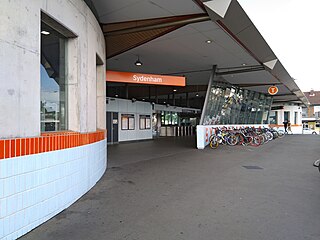
Sydenham railway station is a heritage-listed railway station located on the Illawarra line, serving the Sydney suburb of Sydenham in New South Wales, Australia. It is served by Sydney Trains T3 Bankstown, T4 Illawarra and T8 South services. It was designed by the New South Wales Government Railways and built from 1884 to 1962, with William Robinson having built the original 1884 buildings. It was added to the New South Wales State Heritage Register on 2 April 1999.
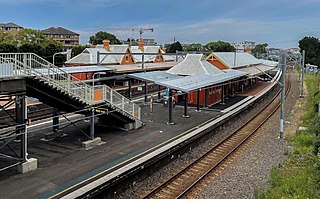
Arncliffe railway station is a heritage-listed railway station located on the Illawarra line, serving the Sydney suburb of Arncliffe in Bayside Council. It is served by Sydney Trains T4 line services. It was added to the New South Wales State Heritage Register on 2 April 1999.

Rockdale railway station is a heritage-listed railway station located on the Illawarra line, serving the Sydney suburb of Rockdale in Bayside Council. It is served by Sydney Trains T4 line services. It was added to the New South Wales State Heritage Register on 2 April 1999.

Fairfield railway station is a heritage-listed railway station located on the Old Main South line, serving the Sydney suburb of Fairfield. It is served by Sydney Trains T2 Inner West & Leppington and T5 Cumberland line services. It was designed and built by NSW Government Railways from 1856 to 1891. It is also known as Fairfield Railway Station group. The property was added to the New South Wales State Heritage Register on 2 April 1999.

Kiama railway station is a heritage-listed intercity train station located in Kiama, New South Wales, Australia, on the South Coast railway line. The station serves NSW TrainLink diesel multiple unit trains traveling south to Bomaderry and electric multiple unit trains north to Wollongong and Sydney. Early morning and late night services to and from stations to the south are provided by train replacement bus services. It was added to the New South Wales State Heritage Register on 2 April 1999.
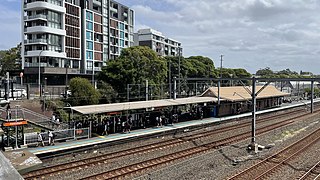
Petersham railway station is a heritage-listed railway station located on the Main Suburban line, serving the Sydney suburb of Petersham. It is served by Sydney Trains T2 Inner West & Leppington line services. It was added to the New South Wales State Heritage Register on 2 April 1999.
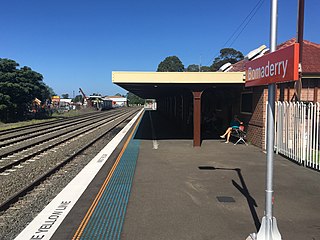
Bomaderry railway station is a heritage-listed single-platform intercity train station located in Bomaderry, New South Wales, Australia, on the South Coast railway line. The station serves NSW TrainLink diesel multiple unit trains to Kiama. Early morning and late night services to the station are provided by train replacement bus services. A siding near the station is used by freight trains operated by the Manildra Group.

St Marys railway station is a heritage-listed former goods yard, railway signal box and now railway station located on the Main Western line in the western Sydney suburb of St Marys in the City of Penrith local government area of New South Wales, Australia. The station is served by Sydney Trains T1 Western line services. The station marks the end of the four-track section of the Main Western line. It was designed by New South Wales Government Railways and was built in 1862. It is also known as St. Marys Railway Station Group and St Marys Railway Station. The property was added to the New South Wales State Heritage Register on 2 April 1999.
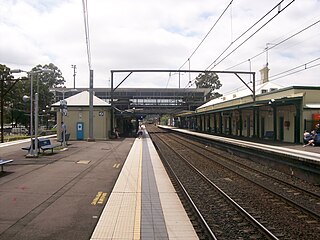
Penrith railway station is a heritage-listed railway station located on the Main Western line in the western Sydney suburb of Penrith in the City of Penrith local government area of New South Wales, Australia. It was designed by New South Wales Government Railways and the 1863 building was built by M. and A. Jamison and D. Forest. It is also known as Penrith Railway Station group. The property was added to the New South Wales State Heritage Register on 2 April 1999.

Wollongong railway station is a heritage-listed railway station on the South Coast railway line in New South Wales, Australia. It serves the central business district of Wollongong. It was added to the New South Wales State Heritage Register on 2 April 1999.

Valley Heights railway station is a heritage-listed railway station located on the Main Western line in Valley Heights, in the City of Blue Mountains local government area of New South Wales, Australia. It was designed and built by NSW Government Railways. It is also known as Valley Heights Railway Station and Locomotive Depot and The Valley. The property was added to the New South Wales State Heritage Register on 2 April 1999.

Springwood railway station is a heritage-listed former railway bridge and now railway station located on the Main Western line in Springwood, City of Blue Mountains, New South Wales, Australia. It was designed by NSW Government Railways and built from 1883 to 1884 by John White, Chas. & Wm. Coghill & Thos. Proull. It is also known as Springwood Railway Station Group. The property was added to the New South Wales State Heritage Register on 2 April 1999. The station opened on 11 July 1867. It previously had a passing loop to the east of Platform 1.

Lawson railway station is a heritage-listed railway station located on the Main Western line in Lawson in the City of Blue Mountains local government area of New South Wales, Australia. It is also known as Lawson Railway Station Group and Christmas Swamp; Blue Mountain. The property was added to the New South Wales State Heritage Register on 2 April 1999. The station opened on 11 July 1867 as Blue Mountain, being renamed Lawson on 21 April 1879. A passing loop exists north of Platform 1. As part of widening work to the Great Western Highway, a siding south of Platform 2 was removed and a new submerged siding constructed west of the station.

Medlow Bath railway station is a heritage-listed railway station located on the Main Western line in Medlow Bath in the City of Blue Mountains local government area of New South Wales, Australia. It was designed by NSW Government Railways and built from 1902 to 1922. The property was added to the New South Wales State Heritage Register on 2 April 1999. The station opened on 21 January 1880 as Browns Siding Pulpit Hill, and was renamed Medlow on 1 March 1883 and Medlow Bath on 1 October 1903.
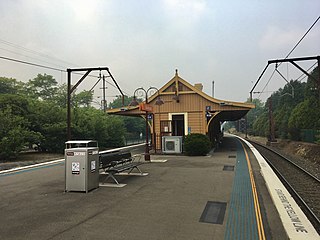
Blackheath railway station is a heritage-listed former railway bridge and now railway station located on the Main Western line in Blackheath in the City of Blue Mountains local government area of New South Wales, Australia. It was designed and built by NSW Government Railways and built from 1897 to 1985. It is also known as the Blackheath Railway Station Group. The property was added to the New South Wales State Heritage Register on 2 April 1999. The station opened on 28 December 1869.
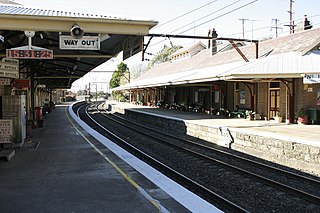
Mount Victoria railway station is a heritage-listed former barracks and now staff accommodation, guest accommodation, railway signal box and railway station located on the Main Western line in Mount Victoria in the City of Blue Mountains local government area of New South Wales, Australia. It was designed by NSW Government Railways and built from 1868 to 1913 by Allan McClean and James Barrie (1868 building). It is also known as Mount Victoria Railway Station group. The property was added to the New South Wales State Heritage Register on 2 April 1999. The station opened on 1 May 1868.

Lithgow railway station is a heritage-listed former station master's residence and railway station located on the Main Western line at Railway Parade, Lithgow, City of Lithgow, New South Wales, Australia. It was designed and built by New South Wales Government Railways and built from 1924 to 1925. It is also known as Lithgow Railway Station Group and Residence and Eskbank East. The property was added to the New South Wales State Heritage Register on 30 August 2013. The station has frequent NSW TrainLink services running to and from Sydney Central.
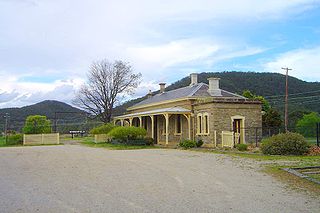
The Bowenfels railway station is a heritage-listed disused railway station and now visitor's centre and restaurant located on the Main Western line in Bowenfels, City of Lithgow, New South Wales, Australia. It was designed by John Clifton and the New South Wales Government Railways and built from 1869 to 1869 by G. Watsford, NSW Government Railway. It is also known as the Bowenfels Railway Station and Stationmaster's House and Old Station Masters Residence and Station. It was added to the New South Wales State Heritage Register on 2 April 1999.

Orange railway station is a heritage-listed former railway bridge and now railway station located on the Main Western line on Peisley Street, Orange in the City of Orange local government area of New South Wales, Australia. It was built from 1877 to 1950. It is also known as Orange Railway Station and yard group. The property was added to the New South Wales State Heritage Register on 2 April 1999.




















